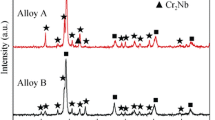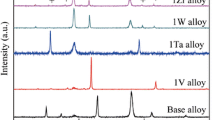Abstract
High-temperature oxidation behavior of directionally solidified (DS) Nb–Si-based alloys with Re additions was investigated at 1200 and 1250 °C, respectively. Microstructures and high-temperature oxidation behavior of the alloys were characterized. Results show that the microstructures in vertical section of Nb–24Ti–15Si–4Cr–2Al–2Hf–xRe (x = 0, 1, 3; at%) alloys grow parallel to the withdrawal direction and the cross section exhibits bud-like structures. The bud-like structures become finer with more Re additions. The weight gain of the Nb–24Ti–15Si–4Cr–2Al–2Hf–3Re alloy after oxidation at 1200 °C for 100 h is 198.1 mg·cm−2, and it is a bit higher at 1250 °C. The other two alloys perform somewhat worse. The influence of Re addition on the oxidation resistance at 1250 °C is more significant than that at 1200 °C. Although Re addition does not benefit obviously the high-temperature oxidation resistance of the DS samples, it does not compromise the oxidation resistance with a certain amount of Re additions in contrast with the alloy without Re addition.







Similar content being viewed by others
References
Bewlay B, Jackson M, Zhao JC, Subramanian PR, Mendiratta MG, Lewandowski JJ. Ultrahigh-temperature Nb–silicide-based composites. MRS Bull. 2003;28(9):646.
Bewlay B, Jackson M, Subramanian PR, Zhao JC. A review of very-high-temperature Nb–silicide-based composites. Metall Mater Trans A. 2003;34(10):2043.
Bewlay B, Jackson M, Lipsitt H. The balance of mechanical and environmental properties of a multielement niobium-niobium silicide-based in situ composite. Metall Mater Trans A. 1996;27(12):3801.
Perepezko JH. The hotter the engine, the better. Science. 2009;326(5956):1068.
Geng J, Tsakiropoulos P, Shao GS. A study of the effects of Hf and Sn additions on the microstructure of Nbss/Nb5Si3 based in situ composites. Intermetallics. 2007;15(1):69.
Ruth MD, Shailendra KV. Short-term oxidation response of Nb–15Re–15Si–10Cr–20Mo alloy. J Mater Res Technol. 2014;3:25.
Vazquez A, Varma SK. High-temperature oxidation behavior of Nb–Si–Cr alloys with Hf additions. J Alloys Compd. 2011;509(25):7027.
Geng J, Tsakiropoulos P, Shao GS. Oxidation of Nb–Si–Cr–Al in situ composites with Mo, Ti and Hf additions. Mater Sci Eng, A. 2006;441:26.
Li Y, Li CR, Du ZM, Guo CP, Zhao XQ. As-cast microstructures and solidification paths of the Nb–Si–Ti ternary alloys in Nb5Si3–Ti5Si3 region. Rare Met. 2013;32(5):502.
Bewlay B, Jackson M, Gigliotti MFX. Niobium silicide high temperature in situ composites. In: Westbrook JH, Fleischer RL, editors. Intermetallic Compounds—Principles and Practice: Progress, Chichester. Vol. 3. Hoboken: Wiley; 2002. 545.
Liu SY, Shang JX, Wang FH, Liu SY, Zhang Y, Li DJ, Shields D, Xue WH, Liu YD, Dang HL. Oxidation of the two-phase Nb/Nb5Si3 composite: the role of energetics, thermodynamics, segregation, and interfaces. J Chem Phys. 2013;138:257.
Murayama Y, Hanada S. High temperature strength, fracture toughness and oxidation resistance of Nb–Si–Al–Ti multiphase alloys. Sci Technol Adv Mater. 2002;3(2):145.
Sierra RM. Effect of rhenium on short term oxidation of niobium based alloys for high temperature applications. Texas: The University of Texas at El Paso; 2014. 4.
Wang T, Guo X. Morphology and phase constituents of mechanically alloyed Nb–Ti–Si based ultrahigh temperature alloy powders. Rare Met. 2011;30(1):427.
Bewlay B, Jackson M, Subramanian PR. Processing high-temperature refractory-metal silicide in situ composites. JOM J Miner Metals Mater Soc. 1999;51(4):32.
Yuan SN, Jia LN, Ma LM, Cui RJ, Su LF, Zhang H. The microstructure optimizing of the Nb–14Si–22Ti–4Cr–2Al–2Hf alloy processed by directional solidification. Mater Lett. 2012;84(10):124.
Su LF, Jia LN, Feng YB, Zhang HR, Yuan SN, Zhang H. Microstructure and room-temperature fracture toughness of directionally solidified Nb–Si–Ti–Cr–Al–Hf alloy. Mater Sci Eng A. 2013;560(1):672.
Mao XY, Fang F, Jiang JQ, Tan RS. Effect of rare earth on the microstructure and mechanical properties of as-cast Cu–30Ni alloy. Rare Met. 2009;28(6):590.
Kindrachuk V, Wanderka N, Banhart J, Mukherji D, Genovese DD, Rosler J. Effect of rhenium addition on the microstructure of the superalloy Inconel 706. Acta Mater. 2008;56(7):1609.
Giamei AF, Anton DL. Rhenium additions to a Ni-base superalloy: effects on microstructure. Metall Trans A. 1985;16(11):1997.
Bai M, Liu ZH, Zhou LJ, Liu ZY, Zhang CF. Preparation of ultrafine rhenium powders by CVD hydrogen reduction of volatile rhenium oxides. Trans Nonferrous Metals Soc China. 2013;23(2):538.
Acknowledgments
This study was financially supported by the National Nature Science Foundation of China (No. 51471013).
Author information
Authors and Affiliations
Corresponding author
Rights and permissions
About this article
Cite this article
Zhang, JC., Jia, LN., Weng, JF. et al. Microstructures and high-temperature oxidation behavior of directionally solidified Nb–Si-based alloys with Re additions. Rare Met. 42, 273–280 (2023). https://doi.org/10.1007/s12598-016-0788-2
Received:
Revised:
Accepted:
Published:
Issue Date:
DOI: https://doi.org/10.1007/s12598-016-0788-2




